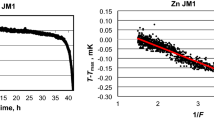Abstract
Continuing our study on aluminum, tin, and silver points, a study on the realization of the zinc point was conducted. Zinc-point cells were newly fabricated using 6N-nominal grade zinc samples, impurity elements of which were analyzed extensively based on glow-discharge mass spectrometry (GDMS). The present paper reports the temperature measurements done using the newly fabricated cells during the zinc freezing process, under which the zinc fixed point is defined, and the analysis of the freezing curve obtained. Comparisons of zinc-point temperatures realized by the newly fabricated cells (cell-to-cell comparisons) were also conducted. Zinc-point depression due to impurity elements was calculated based on the sum of individual estimates and the impurity element analysis. One of the cells evaluated was drawn out from its crucible and analyzed by GDMS at four points, namely, at around the center of the top, of the middle, of the bottom, and around the outer part of the middle area. The purpose of this cell disassembly is to see whether or not there has been some difference before and after cell fabrication, as well as difference in impurity element distribution within the ingot. From the aforementioned studies, some findings were obtained. First finding is that the homogeneity of the zinc ingot was within 30%, except for Pb, which was more concentrated in the center part. Second finding is that the cell-to-cell temperature difference changes along with the progressing solidification process. As a consequence, for an accurate cell-to-cell comparison, the locus in the freezing plateau where the comparison is done should be determined. Third finding is that the slope analysis estimates accurately the cell-to-cell comparison, and is consistent with the impurity analysis. This shows that the slope analysis gives extensive information about the effect of impurity to the zinc-point realization, especially after the cell fabrication.
Similar content being viewed by others
References
Widiatmo J.V., Harada K., Yamazawa K., Arai M.: Metrologia 43, 561 (2006)
Yamazawa K., Widiatmo J.V., Arai M.: Int. J. Thermophys. 28, 1941 (2007)
Widiatmo J.V., Harada K., Yamazawa K., Arai M.: Int. J. Thermophys. 29, 158 (2008)
H. Preston-Thomas, P. Bloembergen, T.J. Quinn, Supplementary Information for the International Temperature Scale of 1990 (BIPM, Sèvres, 1990)
D. Ripple, B. Fellmuth, M. de Groot, Y. Hermier, K.D. Hill, P.P.M. Steur, A. Pokhodun, M. Matveyev, P. Bloembergen, CCT Document CCT/05-08 (2005)
T.B. Massalski, H. Okamoto, P.R. Subramanian, L. Kacprzak, Binary Alloy Phase Diagrams, 2nd edn., vol. 1 (ASM International, Materials Park, OH, 1990)
Ancsin J.: Metrologia 44, 303 (2007)
Fellmuth B., Hill K.D.: Metrologia 43, 71 (2006)
Fahr M., Rudtsch S.: Metrologia 46, 423 (2009)
J.V. Widiatmo, K. Harada, K. Yamazawa, J. Tamba, M. Arai, Int. J. Thermophys. (submitted).
Author information
Authors and Affiliations
Corresponding author
Rights and permissions
About this article
Cite this article
Widiatmo, J.V., Sakai, M., Satou, K. et al. Study on the Realization of Zinc Point and the Zinc-Point Cell Comparison. Int J Thermophys 32, 309–325 (2011). https://doi.org/10.1007/s10765-010-0871-0
Received:
Accepted:
Published:
Issue Date:
DOI: https://doi.org/10.1007/s10765-010-0871-0




